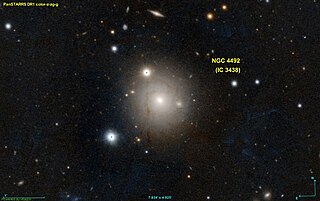
NGC 4492 is a spiral galaxy located about 90 million light-years away in the constellation Virgo. NGC 4492 was discovered by astronomer William Herschel on December 28, 1785. It was rediscovered by astronomer Arnold Schwassmann on January 23, 1900, and was listed as IC 3438. NGC 4492 lies in the direction of the Virgo Cluster. However, it is not considered to be a member of that cluster.

NGC 6040 is a spiral galaxy located about 550 million light-years away in the constellation Hercules. NGC 6040 was discovered by astronomer Édouard Stephan on June 27, 1870. NGC 6040 is interacting with the lenticular galaxy PGC 56942. As a result of this interaction, NGC 6040's southern spiral arm has been warped in the direction toward PGC 56942. NGC 6040 and PGC 56942 are both members of the Hercules Cluster.
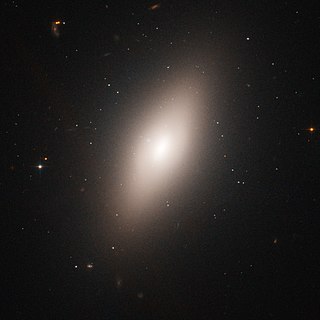
NGC 4660 is an elliptical galaxy located about 63 million light-years away in the constellation Virgo. The galaxy was discovered by astronomer William Herschel on March 15, 1784 and is a member of the Virgo Cluster.

NGC 3860 is a spiral galaxy located about 340 million light-years away in the constellation Leo. NGC 3860 was discovered by astronomer William Herschel on April 27, 1785. The galaxy is a member of the Leo Cluster and is a low-luminosity AGN (LLAGN). Gavazzi et al. however classified NGC 3860 as a strong AGN which may have been triggered by a supermassive black hole in the center of the galaxy.
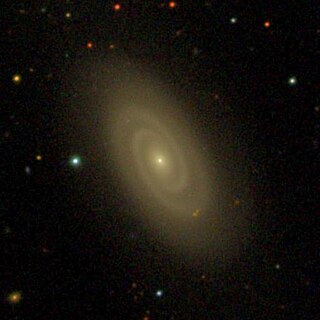
NGC 4305 is a dwarf spiral galaxy located about 100 million light-years away in the constellation Virgo. The galaxy was discovered by astronomer John Herschel on May 2, 1829. Although considered to be a member of the Virgo Cluster, its high radial velocity and blue luminosity suggest it is in fact a background galaxy. The galaxy has a nearby major companion; NGC 4306.

NGC 4320, is a peculiar galaxy located about 370 million light-years away in the constellation Virgo. It was discovered by astronomer Heinrich d'Arrest on April 15, 1865 and is a member of the NGC 4325 Group.
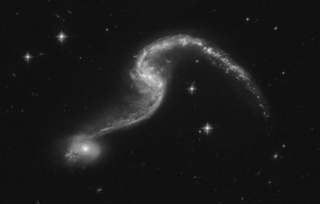
NGC 646 is a large barred spiral galaxy located in the constellation Hydrus. Its speed relative to the cosmic microwave background is 8,145 ± 19 km/s, which corresponds to a Hubble distance of 120.1 ± 8.4 Mpc. NGC 646 was discovered by British astronomer John Herschel in 1834. It forms an interacting galaxy pair.

IC 4271 is a spiral galaxy located some 800 million light-years away in the Canes Venatici constellation. It is 130,000 light-years in diameter. IC 4271 was first located on July 10, 1896, by Stephane Javelle, a French astronomer. It hosts a Seyfert type 2 nucleus, containing an acceleration disc around its supermassive black hole which releases large amounts of radiation, hence its bright appearance. IC 4271 appears to be interacting with its smaller neighboring galaxy, PGC 3096774.

IRAS 14348-1447 known as PGC 52270, are a pair of spiral galaxies located 1 billion light-years away in the constellation of Libra. The galaxy IRAS 14348-1447NE, is in the early process of merging with IRAS 14348-1447SW, causing gravity to pull stars from both galaxies and forming tidal tails. As the interaction takes place, molecular gas is swirled about and creating emission that is responsible for the galaxies' ultraluminous appearance.
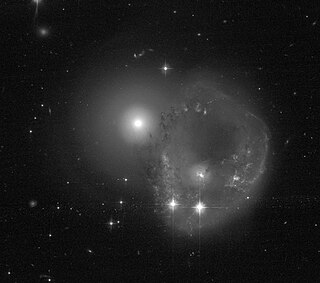
UGC 1840 known as Arp 145, are a pair of interacting galaxies located 250 million light-years away from the Solar System in the Andromeda constellation. Made up of two galaxies, UGC 1840 NED01 and UGC 1840 NED02, the two galaxies had recently collided with each other in which the elliptical galaxy has penetrated through the spiral galaxy's nucleus leaving a hole in its middle, thus forming a ring galaxy. With a diameter of 1.3 arc minutes, close to 100,000 thousand light-years, they are roughly the same size as the Milky Way.

NGC 6331 is a type E elliptical galaxy located in the Ursa Minor constellation. It is located 737 million light-years from the Solar System and was discovered by German-British astronomer William Herschel on December 20, 1797, utilizing an 18.7-inch f/13 spectrum telescope but also observed by Guillaume Bigourdan.
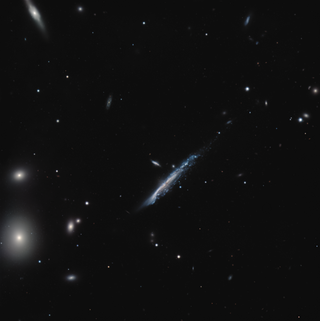
UGC 6697 is a large irregular spiral galaxy with a bar located in the Leo constellation. It is located 378 million light-years from the Solar System and has an estimated diameter of 205,000 light-years. UGC 6697 is considered a starburst galaxy which produces high rates of star formation.

ESO 69-6 collectively known as AM 1633-682, is a pair of interacting galaxies located 654 million light-years away in the constellation of Triangulum Australe. They are made of two galaxies: ESO 069-IG 006N known as IRAS 16330-6820, and ESO 069-IG 006S known as LEDA 285730.

SDSSCGB 10189 is a trio of interacting galaxies that is located in the constellation of Boötes. They are located 1.04 billion light-years away from the Solar System and are gravitationally interacting.

IC 1166 are a pair of galaxies in the Corona Borealis constellation comprising IC 1166 NED01 and IC 1166 NED02. They are located 977 million light-years from the Solar System and were discovered on July 28, 1892, by Stephane Javelle.

NGC 3751 is a type E-S0 lenticular galaxy located in the Leo constellation. It is located 450 million light-years away from the Solar System and was discovered by Ralph Copeland on April 5, 1874.
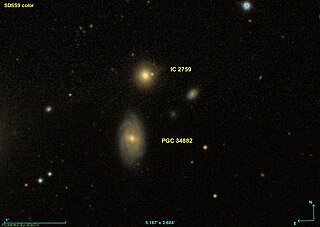
IC 2759 is a small type E elliptical galaxy located in the constellation of Leo. It is located 350 million light-years away from the Solar System and was discovered on April 24, 1897, by Guillaume Bigourdan. Sometimes IC 2759 is confused with the spiral galaxy, PGC 34882 which is located south of the galaxy.

NGC 5098 are a binary pair of distant galaxies located in Canes Venatici constellation. They are made up of one Type E elliptical galaxy, PGC 46529 or NGC 5098 NED01 located east and one Type ES-0 lenticular galaxy, PGC 46515 or NGC 5098 NED02 located west. Both galaxies are located 559 million light-years away from the Solar System and were discovered on April 29, 1827, by John Herschel.
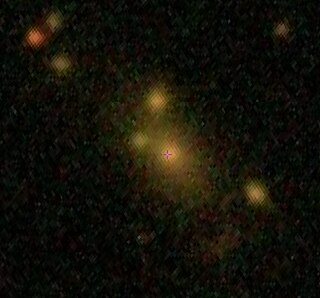
4C+55.16 is an elliptical galaxy, classified type E, located in Ursa Major. The galaxy lies about 2.84 billion light-years from Earth, which means given its apparent dimensions, 4C+55.16 is approximately 445,000 light-years across making it a type-cD galaxy. It is the brightest cluster galaxy (BCG) in a cluster bearing its same name and a part of the galaxy cluster called WHL J083454.9+553421.

PG 0844+349, also known as TON 951, is a galaxy in the southern constellation Lynx, near the border of Cancer. Its redshift is 0.064000, putting the galaxy at 849 million light-years away from Earth.





















